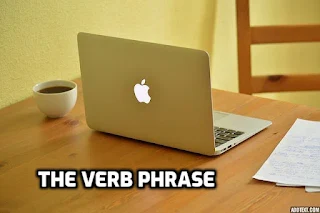Grammar | SPOCA | The Verb Phrase
English Grammar
SPOCA
The Verb Phrase
i.e., no Verb element means no Predicate and, consequently, no sentence. In other words, the Verb element plays a central role in sentence structure as it is the most obligatory of all its elements;
Example:
THAT OLD MOROCCAN SHEIKH STILL EATS SMEN BY THE SPOONFUL.
👉 That old Moroccan sheikh | still | eats | smen | by the spoonful.
S | V | O | (A)
In this sentence, other elements can be omitted, but not the Verb element; we can omit:
The adverbial: That old Moroccan sheikh eats smen.
The object: That old Moroccan sheikh eats by the spoonful.
The subject, in informal style: Eats smen by the spoonful (probably pointing to him or nodding in his direction).
But we cannot omit the verb: That old Moroccan sheikh smen by the spoonful.
The Verb element may include the MAIN VERB alone or all the other elements of the verb group which is called the VERB PHRASE. The main verb, also called the lexical verb, is the final verb in a verb phrase and expresses the lexical meaning of the verb phrase such as:
Talk and shop in: He doesn’t talk while chopping onions.
Drink in: I don't drink tea with sugar.
Negotiate in: They have been negotiating since Friday.
The Verb Phrase (VP) can be constructed as follows: ( {Aux} {Aux} {Aux} {Aux} V )
This formula can be read thus:
In a Verb Phrase, the element (V) is compulsory and may be preceded by one, two, three or four optional { } auxiliaries. The auxiliaries, also called the helping verbs, work with the V element to express a more precise meaning.
A) Carlos | came | home | yesterday
S | V | A | (A)
B) Carlos | has come | home | this morning
S | V | A | (A)
Sentence A: the verb phrase consists of the V alone: 'came'.
Sentence B: the verb phrase consists of the V ‘come’ preceded by one auxiliary; ‘has’. Its pattern is SVA(A) and can NOT be analyzed as …………….S+V+V+A+ (A).
🔔 A main sentence, clause has only one V but it may have one or more Subordinate Clause(s) which have their own verbs; i.e., whenever there is a Verb there is a CLAUSE.
Examples:
_ Why did you go?
↳ I | went | to see her.
S | V | A
⇨ This is a complex sentence where the Subordinate Clause, ’to see her,’ is an Adverbial (of purpose or reason)
_ What do you want?
↳ I | want | to see her.
S | V | O
⇨ This is a complex sentence where the Subordinate Clause, (To see her) is an object The two sentences overleaf can be barred and labelled thus:
[ ( I ) (went [ to see her ] ) ]
NP-S VP-P Non-finite to-infinitive adverbial clause – A
Because (to go) is a verb of movement, the Subordinate Clause, (to see her), functions, per force, as A. This A is an Adverb Complement (AC).2
🔔 The pattern of the SPA is one of the seven patterns of the English sentence, so the adverb element A is compulsory but, here, it is not just a Phrase, it is a Clause (and, of course, like all clauses, it contains phrases). The whole subordinate clause, (to see her), functions as the main verb, (went). In other words, since our focus is to analyze the elements of the sentence, (I went to see her), we have to consider ‘to see her’ as one sentence element; consequently, we do not need to analyze its constituents (its phrases). The same can be said about the following sentence:
[ ( I ) (want [ to see her ] ) ]
NP-S VP-P Non-finite to-infinitive nominal clause – O
Because (to want) is a transitive verb, the Subordinate Clause, per force, functions as O.
🔔 Again, the pattern of the SPO is one of the seven patterns of the English sentence, so the object element O is compulsory but, here, it is not just a phrase, it is a clause (and, of course, like all clauses, it contains phrases). The whole subordinate clause, ‘to see her’, is an object clause as it functions as O the main verb, (want). In other words, since our focus is to analyze the elements of the sentence: ‘I went to see her’, we have to consider ‘to see her’ as one sentence element; consequently, we do not need to analyze its constituents (its phrases).
 |
| SPOCA |







..jpg)









No comments